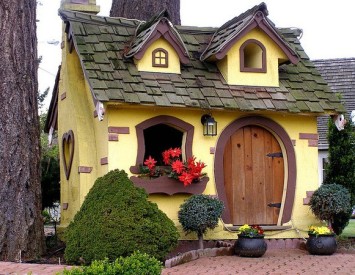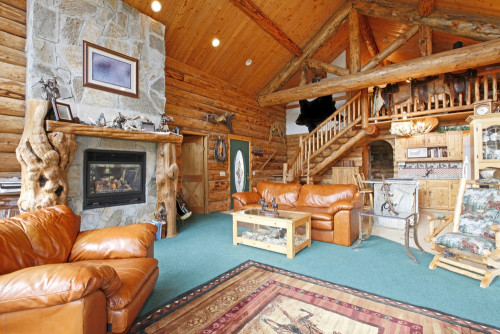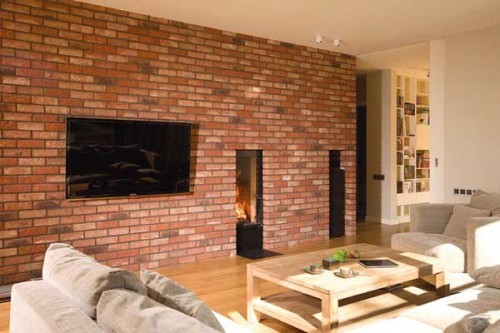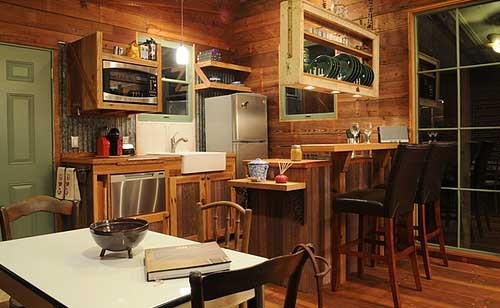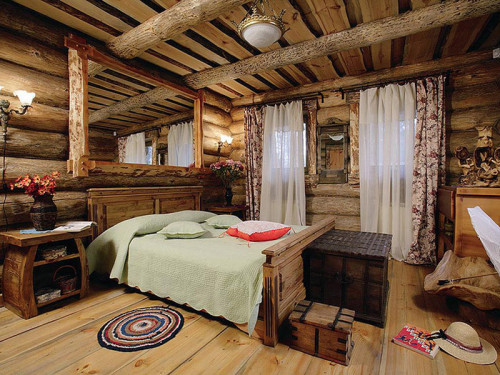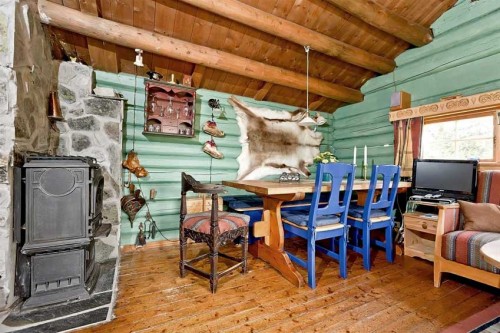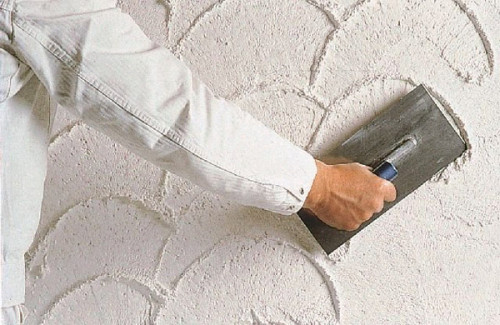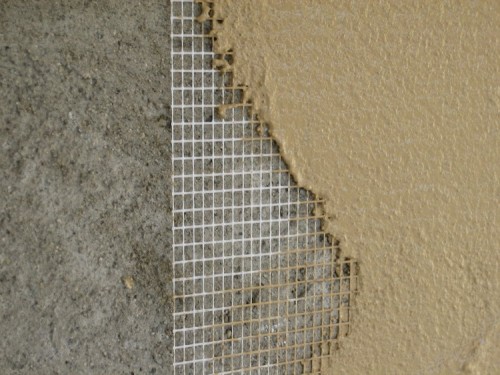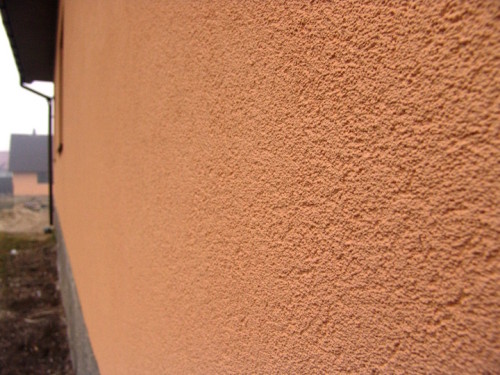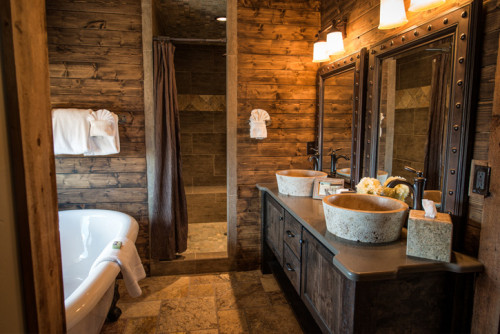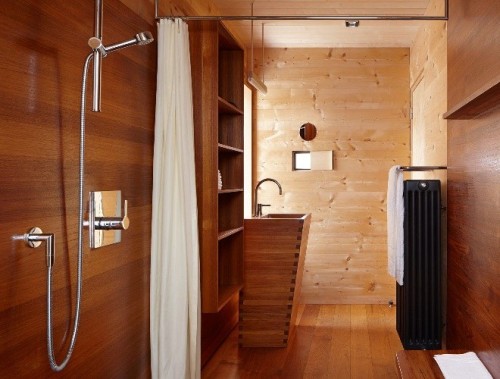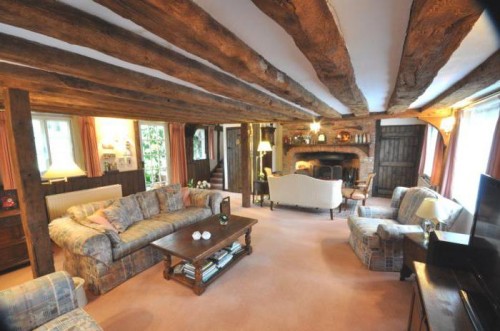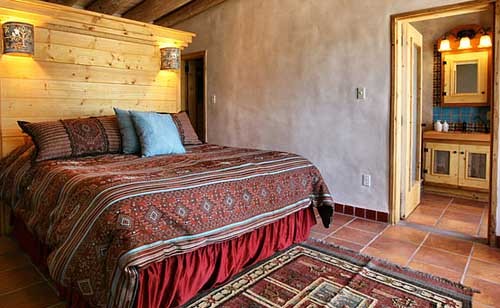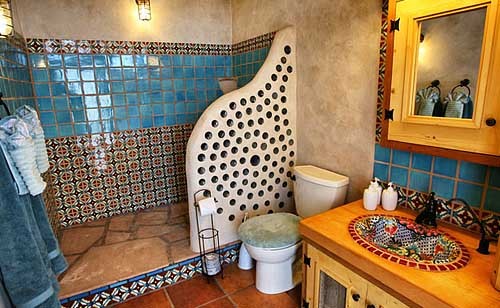Most people rightly consider the cottage the best place to relax, so they try to make it as comfortable with all their might. However, when decorating walls in the country, it is important not to turn it into another apartment, but to make the interior diametrically opposite. However, in most cases, one has to start from the financial side of the issue, forgetting about the psychology of the interior. In this article, we will tell you how and with the help of which to turn any cottage into a cozy place, where you want to spend every minute of free time.
Content
Wall decoration ideas in the country
Any city resident wants to escape from city noise and fuss from time to time to feel unity with nature and himself. The cottage for many is just such a “rescue island”, therefore it is very important to pay its inner and external decoration maximum attention. Your psychological state and the level of comfort during rest directly depend on what materials and technologies you will use.
The use of supporting structures
Before starting wall decoration in the country with your own hands, look carefully - maybe the construction of the house itself is already hinting that you can minimize repair work, profitably beat the surfaces. Very often, people do not notice that in the interior you can favorably use constructive elements of the house: beams, partitions, rafters or the walls themselves.
This finishes are best obtained in timber and log houses, since it is simple and pleasant to work with a tree - you just need to clean the surface, treat with an antiseptic and cover it with varnish. If desired, you can artificially aging wood or tint it with a stain in order to simulate an expensive breed.
If there is an attic in the house, do not hesitate to use in creating the interior of the rafters and ceiling beams. Many simply overlap them with boards or drywall, forming a familiar and boring ceiling, but why deliberately reduce the space when you can enjoy the open spaces and beat the rafters beautifully, decorating them with lighting devices or decorative elements. Try to cover them with contrasting paint in relation to other surfaces. To strengthen thermal insulation, lay the insulation between the rafters, and then sew these intervals with boards, lining or block house imitating the beam. In order to visually expand the space even more, place the bar not across the rafters, but along them. You can supplement any wooden decoration with a decorative natural or artificial stone. These two natural materials are perfectly combined with each other and create a favorable calm atmosphere in the house.
If your cottage is built of brick, its structural elements can also be favorably presented as decorative. For example, try to leave a brick wall without finishing, stripping its surface, processing the seams and covering with protective varnish. It remains only to supplement the interior with metal accessories, put a glass table, a vintage hanger for clothes or a minimalist iron sculpture, and you will get a stylish room in the loft style. If the brick is not grinded with sandpaper, but leave it as it is, you can create an imitation of an old masonry and beat the interior accordingly. Naturally, the cost of such a “finish” will be meager.
Wood trim
Wood decoration is the most common option for a summer residence. The most suitable material is a wooden lining, since it not only looks attractive, but also differs in strength, durability and simplicity of styling. Even the most miniature cottage can be turned into a cozy “nest” using a lining made of natural wood, and if you cover it with a special transparent impregnation, you can emphasize a unique natural pattern.
If you have always dreamed of living in a log house, but fate was generous only into a brick or concrete dacha, moving the walls with a block house to create the effect of log walls. But it is best, of course, to use materials from natural wood, since only in this case you can count on a unique atmosphere that can reign only in a wooden house.
The tree can be used not only for the direct skin of the walls, but also to change the geometry of the premises. So, for example, you can build niches and shelves, while overlapping the walls, creating a decorative surface and bringing a functional element to the interior. Thus, you will avoid additional expenses for the purchase of furniture and save free space. A tree is an ideal material for decorating small rooms, since it allows you to use all the "non -working" corners.
Plywood, as a derivative of wood, is also often used in the interior wall decoration in the country. It stands inexpensive, creates a perfectly flat surface, helps to quickly and efficiently close thermal insulation. Plywood bends well, which means with its help you can build arched passages. In most cases, plywood sheets require subsequent decorative finishes, but there are models with a beautiful wood texture that is quite simply varnished. The coloring of plywood is no different from the color of ordinary wood: cover with impregnation, stain, apply paint or varnish.
Useful advice: Previously, all the walls in the room were finished equally, and this is still considered normal. But in fairness it is worth noting that this is a very obsolete way. Try to “dilute” the same type of interior, covering one of the walls not with wood, but, say, with decorative stone or paint. This option will look much more interesting and more dynamic. As an option, you can also use wooden material, but another plan, for example, a cork coating or laminate.
Wall painting
Wall painting is one of the simplest and fastest in the performance of the methods of wall decoration in the country. The cost of such a venture is also low, so many economical owners prefer paint to the rest of the materials.
A wide selection of all kinds of compositions allows repairs in any room with different operational features. So, there are paints for dry rooms or rooms with a high level of humidity, for children's, bedrooms, etc. An article "will help you deal with this" Wall paint: choices of choice". How to choose and use paint in different rooms, is described in detail in articles " Wall painting in the bathroom: step -by -step instructions», « Wall painting in the kitchen: step -by -step instructions", And " DIY wall painting».
Consider briefly types of paint used for wall decoration:
- Vodmulsionic - a budget option for those who want to make quick and accurate repairs. The paint consists of natural components, and therefore completely safe for people, animals and the environment. Proof of this is the almost complete lack of smell. The water -based sold is sold in buckets from 1 liter, has white. To get the desired shade, it needs to be overwhelmed by adding a special liquid pigment.
- Acryl is a quick -drying paint without smell. Of the main advantages, it is also worth noting the widest color palette, bright saturated shades. The paint has water -repellent properties, but is not intended for too wet rooms.
- Latex - lace -based interior paints more steadily withstand contacts with water, moreover, they can be washed, and they are completely harmless to health. For this reason, latex paints are often used to finish the walls of the cottage in the kitchen and in the nursery.
- Decorative - a series of colors that can simulate various surfaces: masonry, silk, stone, sand, etc.
Wall decoration with panels
Plastic panels do not create such a cozy atmosphere in the house as wood or brickwork, but they are very inexpensive and help to quickly mask the wall defects. This is one of the most common ways of internal and external wall decoration in the country. The price of panels depends on their composition, thickness and other technical characteristics. The main advantage of this material is that for its laying there is no need to carefully level the walls, as is necessary, for example, for coloring.
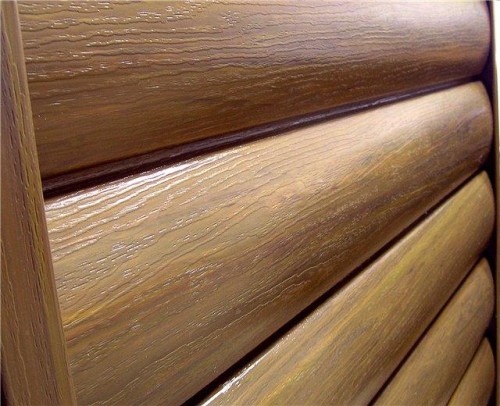
Another important advantage of plastic panels - they withstand high humidity, which can not be said about wood. For internal and outdoor decoration, there are types of panels, but recently siding, designed for facades, can be increasingly found inside the house. It looks good on the verandas, kitchens, attic. At the same time, masters use only vinyl models, leaving metal products for external cladding.
The variety of textures and colors also speaks in favor of the panels, which allows not only to choose the option to your taste and for any interior, but it is also profitable to combine various panels to achieve the original effect. About how to install siding is described in detail in the articles " Plastic siding: choice and installation" And " Metal siding. Installation instructions».
We have listed only a few options for the internal and exterior decoration of the country house, but there are much more materials and methods. You can finish the walls with decorative stone, plaster, glue wallpaper, tiles - everything is limited only by your imagination and budget.
Features of wall decoration in the country
As you know, the decoration of the house can be internal and outer. In this chapter, we will consider in detail how each of the processes occurs using the example of using one of the most popular materials - plaster. Depending on the composition, it can be used both inside the house and outside. Facade plaster contains special components that prevent destruction from atmospheric and mechanical influences. In addition to the composition of the mixtures, technologies for their application are also distinguished.
Wall decoration inside
Any hardworking owner will cope with the application of the plaster, but the only prerequisite is that the solution should be applied to a flat surface. If the walls of your country house are made of brick or have chips and cracks, they must be previously leveled. To do this, you can use one of the types of plasters, plywood or drywall. Alignment with plastering solution is advisable if the surface drops on horizontal are no more than 4-5 cm. Otherwise, the mixture consumption will be too large, and the thick layer can fall off under its own weight. In such situations, it is better to align the walls with sheet material: plywood or drywall.
If the wall is even, and you just decided to change the finish, clean the surface from the previous coating (wallpaper, whitewashing, plaster) with a metal brush, and then cover with several layers of adhesive primer. If you make repairs in the kitchen or cottage is in the region with high humidity, it is better to add the walls to the walls with antiseptics and enhance the waterproofing. For concrete walls, a waterproof primer of deep penetration can be advised.
Consider briefly what types of plaster are there:
- Cement - it is she who align the walls with small differences. It consists of mineral components that are resistant to moisture differences, temperature, and mechanical influences. Cement plaster can be used for internal and external decoration. Of the advantages, you can also highlight low cost and simplicity of application. Of the shortcomings - the need for finish decorative processing.
- Gypsum - this plaster gives a perfectly even and smooth surface, but does not endure high humidity. The gypsum solution freezes very quickly, which on the one hand accelerates the repair, on the other, it does not allow to knead a large volume at once. Gypsum plaster can be used not only for leveling the wall, but also to create an original texture and even casts. Perfectly white color of a frozen solution creates ideal conditions for the subsequent coloring or worship of wallpaper. If desired, you can add a dye to the solution and get a ready -made colored surface.
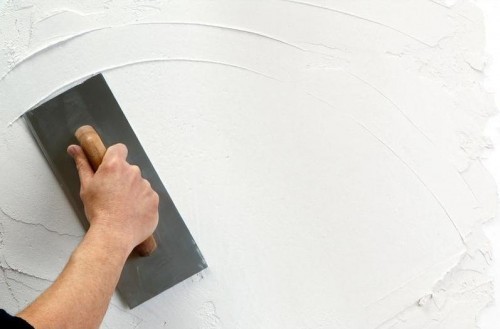
- Decorative is a whole series of plasters with various decorative effects. The solutions are applied with a finish layer to any even surface. They can imitate the skin, dried earth, brickwork, wood, drunk with firecracial beetles, etc. Apply decorative plaster with a layer no thicker than 5 mm (depending on the type and composition) with a special tool “ironing”. Working with fine -grained compositions, you can create interesting effects by the movements of the spatula along different trajectories: straight, arc, wave, around, etc.
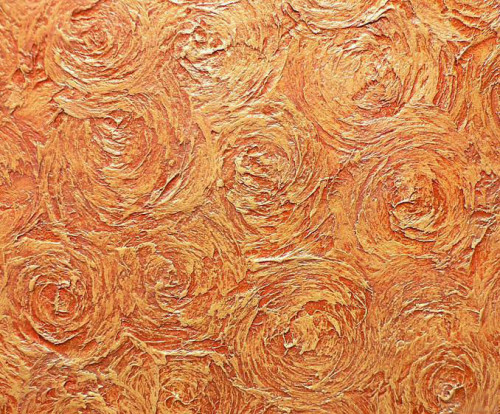
After processing the entire wall with decorative plaster, it is necessary to leave it to dry for 8-12 hours, and then walk along the surface with fine-grained sandpaper to remove the dried drops of the solution. Next, you can start painting or protect the plaster with a water -repellent agent.
Wall decoration outside
You should start external decoration of the walls of the country house only after laying thermal insulation, and this is best done outside. Firstly, so you will save a useful living space, and secondly, avoid the dumping of the walls due to the movement of the dew point inside to the insulation. Articles will help you with this " DIY Wooden War" And " House insulation of the facade of the house with polystyrene».
The quality of work by 70% depends on the correctly selected materials. So, in addition to special facade plaster, you will need a facade reinforcing mesh that will firmly hold the solution on the wall and will not allow it to fall off from humidity or gusts of wind.
Types of external plaster:
- Acrylic - convenient in that it does not require mixing and is already ready for use, which avoids errors. The solutions are of good vapor permeability, enhance the heat and sound insulation of the house. It is quite elastic, which means it can evenly cover the surfaces with any configuration. A large palette makes you forget about typical white houses and color your cottage in any color.
- Silicone - good in that it reliably protects the walls from moisture penetration, but does not interfere with vapor permeability. Creates a dense elastic layer that can be washed and constantly maintained the cleanliness of the facade. The only drawback is the high cost.
- Silicate - plaster based on liquid glass. It is mainly used for decoration of facades from cellular concrete, since it fills all cracks and voids, creating a dense but vapor permeable water barrier.
- Mineral - cement plaster in increased strength. It costs cheaper than all of the above analogues, but it does not differ in elasticity or attractiveness, and therefore requires application skills and subsequent decoration. It is mainly used to align the facade and enhance the thermal insulation of the walls.
Regardless of the chosen type of plaster, it is necessary to first prepare the wall. First, evaluate its condition, if necessary, plunge cracks, chips, remove the previous coating. If the wall is not insulated, lay the thermal insulation material: mineral wool, foam or its derivatives. For better adhesion of the plaster with the wall surface, it is necessary to primed. For concrete, use a special primer Betakontakt.
The application technology depends on the purpose of the plaster. So, if you are dealing with a decorative solution, the principle of work does not differ from the interior decoration, where you wield a “ironing” and a spatula. If plaster is needed for leveling, first you need to install beacons and work as a construction rule. You will find more information on this topic in the article " How to align the walls correctly».
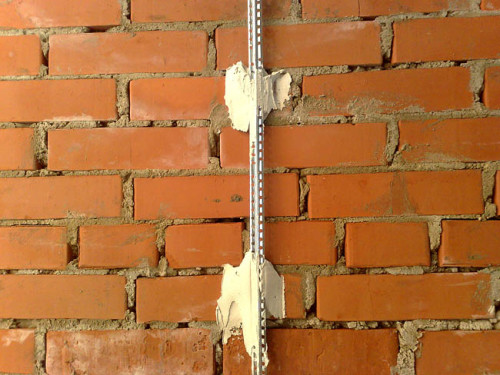
Useful advice: facade work should only be carried out in dry and warm weather so that the plaster can properly dry, so look at the forecast for the next few days.
Summarizes the above information video about wall decoration in the country:
